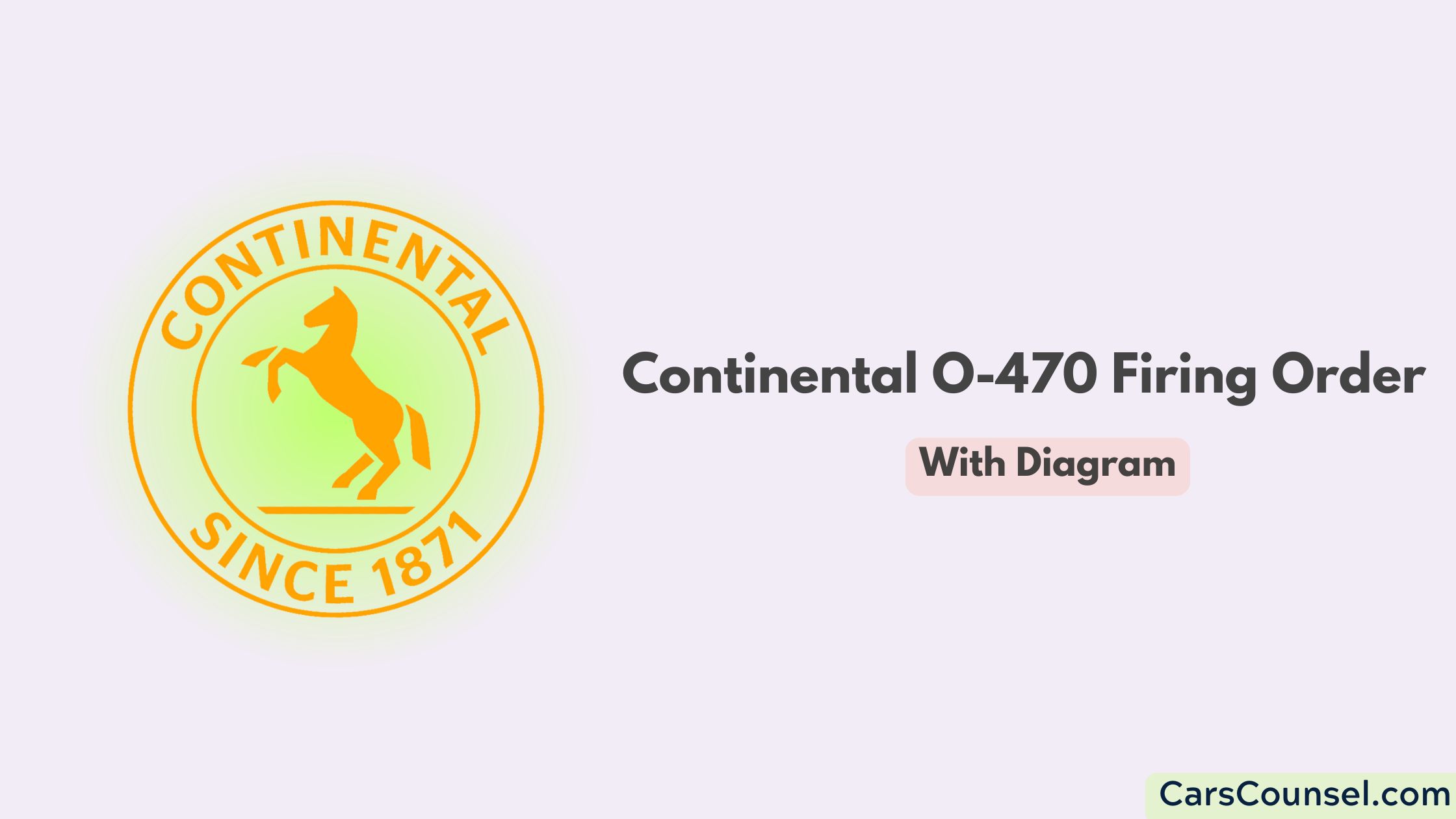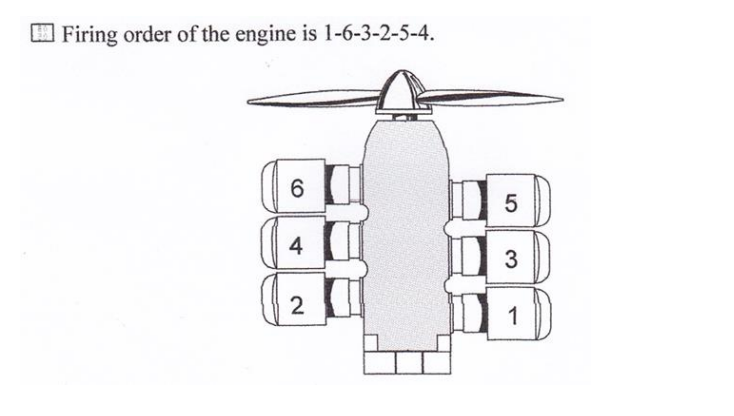The Continental O-470 engine is a six-cylinder, horizontally opposed, air-cooled engine widely used in general aviation. Known for its reliability and durability, this engine powers many aircraft models, including the Cessna 182 Skylane, Beechcraft Bonanza, and other popular light aircraft.
A crucial aspect of its smooth operation is its firing order, a carefully engineered sequence that ensures the engine runs efficiently and reliably.
In this article, we’ll explore the firing order of the Continental O-470 engine, its importance, and its role in maintaining optimal engine performance. Whether you’re an aviation enthusiast, pilot, or mechanic, this guide will give you a thorough understanding of this essential component.

Quick Navigation
The Continental O-470 Firing Order
The firing order for the Continental O-470 engine is: 1-6-3-2-5-4

How the Firing Order Works
- Cylinder 1 Fires First: Located on the right bank, the frontmost cylinder initiates the combustion cycle.
- Cylinder 6 Fires Next: Ignition moves to the rearmost cylinder on the left bank.
- Cylinder 3 Fires Third: The middle cylinder on the right bank fires next.
- Cylinder 2 Fires Fourth: Ignition shifts to the front cylinder on the left bank.
- Cylinder 5 Fires Fifth: The rearmost cylinder on the right bank fires next.
- Cylinder 4 Fires Last: The sequence ends with the middle cylinder on the left bank before restarting with Cylinder 1.
This pattern alternates combustion events between the left and right banks, maintaining balance and smooth operation.
Why Continental Uses the 1-6-3-2-5-4 Firing Order
The 1-6-3-2-5-4 firing order was chosen for the O-470 engine to ensure optimal performance. Here’s why it works:
- Balance: Alternating between opposing banks reduces vibration and stress on the crankshaft.
- Efficiency: Properly spaced combustion events improve fuel-air mixture combustion.
- Smooth Power Delivery: The firing sequence ensures one cylinder is always in its power stroke, maintaining steady torque output.
- Durability: Distributes stress evenly across the engine components, reducing wear and tear over time.
What Is a Firing Order?
The firing order is the sequence in which an engine’s cylinders fire or ignite the air-fuel mixture. This combustion produces the power necessary to drive the pistons and rotate the crankshaft. In the O-470, the firing order is designed to balance the engine, reduce vibrations, and ensure efficient operation.
Why Is the Firing Order Important?
- Smooth Engine Operation: Ensures combustion happens evenly, minimizing vibrations.
- Performance: Delivers consistent power output for smooth flight and reliable performance.
- Efficiency: Optimized firing reduces fuel consumption and ensures complete combustion.
- Durability: Prevents uneven wear on engine components, extending their lifespan.
Overview of the Continental O-470 Engine
The Continental O-470 is a six-cylinder, horizontally opposed, air-cooled engine with a displacement of 470 cubic inches. It is part of the larger Continental Motors family and has been a cornerstone in aviation for decades due to its robust design and reliable performance.
Key Features of the O-470
- Horizontally Opposed Layout: Six cylinders arranged in two banks of three, positioned opposite each other.
- Air-Cooled: Relies on airflow to maintain engine temperature during operation.
- Four-Stroke Cycle: Operates on intake, compression, power, and exhaust strokes.
- Cylinder Numbering:
- Right Bank: Cylinders 1, 3, and 5 (front to back).
- Left Bank: Cylinders 2, 4, and 6 (front to back).
Identifying the Firing Order
Understanding and verifying the firing order is essential for maintenance, troubleshooting, and ensuring proper assembly. Here are ways to identify the firing order in the Continental O-470 engine:
Check the Engine Manual
The engine manual contains detailed specifications, including the firing order and cylinder numbering. This is an essential reference for mechanics and pilots.
Locate Cylinder Numbers
Cylinder numbers are typically stamped on the engine block or near the spark plugs, making it easier to identify their positions.
Use Timing Marks
The crankshaft or magneto timing marks can help confirm the firing order during inspections or maintenance.
Symptoms of Incorrect Firing Order
An incorrect firing order can cause several noticeable issues that impact engine performance, safety, and efficiency. Here are the common symptoms:
Performance Issues
- Engine Misfires: Cylinders fail to fire correctly, resulting in rough performance.
- Rough Operation: The engine vibrates excessively or runs unevenly.
- Power Loss: A disrupted firing sequence reduces overall power output, affecting flight performance.
- Increased Fuel Consumption: Inefficient combustion leads to higher fuel usage and increased emissions.
- Overheating: Misfiring cylinders can overheat, risking damage to the engine.
Causes of Incorrect Firing Order
- Misconnected Spark Plug Wires: Spark plug wires routed to the wrong cylinders disrupt the sequence.
- Faulty Magneto Timing: Misaligned magnetos can cause incorrect ignition timing.
- Worn Components: Damaged spark plugs, ignition leads, or magnetos can interfere with proper firing.
Diagnosing and Fixing Firing Order Problems
If you suspect a firing order issue in your Continental O-470 engine, follow these steps to diagnose and resolve it:
Diagnostic Steps
- Inspect Spark Plug Wires: Ensure each wire is connected to the correct cylinder based on the 1-6-3-2-5-4 sequence.
- Check Magneto Timing: Use timing marks to confirm that the magnetos are synchronized with the crankshaft.
- Perform a Compression Test: Verify that all cylinders have adequate compression for proper combustion.
- Use a Timing Light: Confirm ignition timing using a timing light and compare it to manufacturer specifications.
Fixing Common Issues
- Reconnect Spark Plug Wires: Ensure wires are routed to their corresponding cylinders in the correct firing order.
- Adjust Magneto Timing: Realign the magnetos to ensure proper synchronization with the crankshaft.
- Replace Faulty Components: Install new spark plugs, ignition leads, or magnetos if they are worn or damaged.
Preventative Maintenance for Firing Order Reliability
Maintaining the correct firing order is essential for ensuring the long-term reliability and performance of the Continental O-470 engine. Follow these preventative maintenance tips:
Regular Inspections
- Check the condition of spark plugs, ignition leads, and magnetos during routine maintenance.
- Look for loose connections, wear, or signs of corrosion.
Replace Components as Needed
- Replace spark plugs and ignition wires at intervals recommended by Continental.
- Use OEM components to ensure compatibility and reliability.
Verify Timing
- Periodically check and adjust magneto timing to maintain accurate ignition.
- Perform timing inspections during scheduled maintenance or after significant repairs.
Engines with Similar Firing Orders
FAQs About the Continental O-470 Firing Order
Can I Change the Firing Order?
No, the firing order is fixed by the engine’s design and crankshaft configuration. Altering it would require extensive modifications.
What Happens If the Firing Order Is Incorrect?
An incorrect firing order can cause misfires, rough running, power loss, and potential damage to engine components.
How Can I Verify the Firing Order?
Refer to the engine manual, inspect cylinder markings, and use timing tools to confirm the ignition sequence.
Is the Firing Order the Same for All Continental Engines?
No, while some Continental engines share similar firing orders, variations exist depending on the model and configuration.
Conclusion
The 1-6-3-2-5-4 firing order is a critical aspect of the Continental O-470 engine’s operation, ensuring smooth performance, balanced power delivery, and efficient combustion. Understanding this sequence is essential for maintaining and troubleshooting the engine, as well as ensuring safe and reliable flight performance.
By adhering to proper maintenance practices and addressing issues promptly, you can keep your O-470 engine running at its best. Whether you’re a pilot, mechanic, or aviation enthusiast, knowing the firing order is an essential step in mastering this dependable and widely respected engine.

